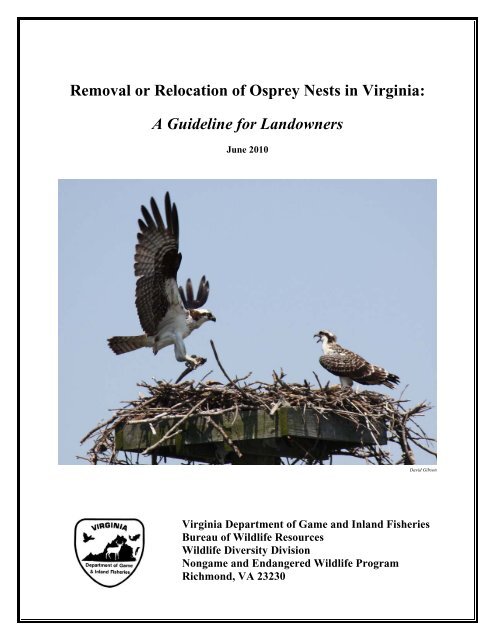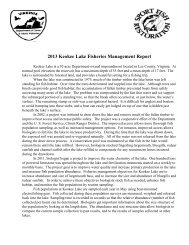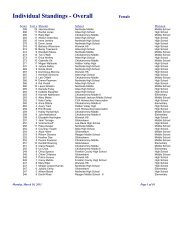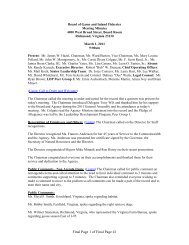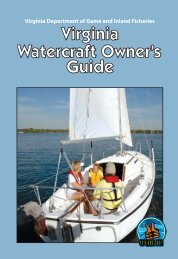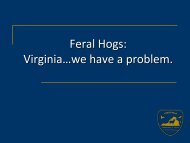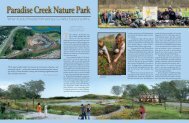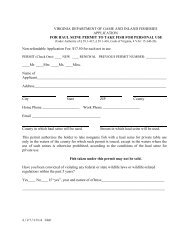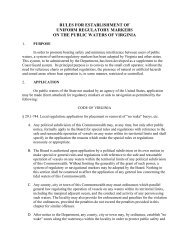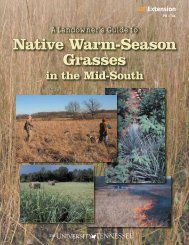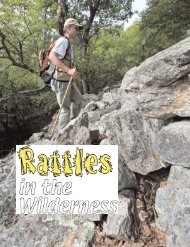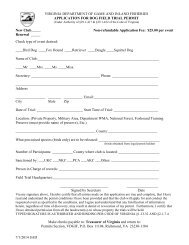Osprey Guidelines - Virginia Department of Game and Inland Fisheries
Osprey Guidelines - Virginia Department of Game and Inland Fisheries
Osprey Guidelines - Virginia Department of Game and Inland Fisheries
You also want an ePaper? Increase the reach of your titles
YUMPU automatically turns print PDFs into web optimized ePapers that Google loves.
Removal or Relocation <strong>of</strong> <strong>Osprey</strong> Nests in <strong>Virginia</strong>:<br />
A Guideline for L<strong>and</strong>owners<br />
June 2010<br />
David Gibson<br />
<strong>Virginia</strong> <strong>Department</strong> <strong>of</strong> <strong>Game</strong> <strong>and</strong> Inl<strong>and</strong> <strong>Fisheries</strong><br />
Bureau <strong>of</strong> Wildlife Resources<br />
Wildlife Diversity Division<br />
Nongame <strong>and</strong> Endangered Wildlife Program<br />
Richmond, VA 23230
Removal or Relocation <strong>of</strong> <strong>Osprey</strong> Nests in <strong>Virginia</strong>:<br />
A Guideline for L<strong>and</strong>owners<br />
June 2010<br />
This report may be cited as follows:<br />
<strong>Virginia</strong> <strong>Department</strong> <strong>of</strong> <strong>Game</strong> <strong>and</strong> Inl<strong>and</strong> <strong>Fisheries</strong>. 2010. Removal or relocation <strong>of</strong> osprey<br />
nests in <strong>Virginia</strong>: A guideline for l<strong>and</strong>owners. <strong>Virginia</strong> <strong>Department</strong> <strong>of</strong> <strong>Game</strong> <strong>and</strong> Inl<strong>and</strong><br />
<strong>Fisheries</strong>, Bureau <strong>of</strong> Wildlife Resources, Wildlife Diversity Division, Nongame <strong>and</strong> Endangered<br />
Wildlife Program. Richmond, VA. 8 pp.<br />
This report was completed with funds provided under<br />
the Federal Aid in Wildlife Restoration Program<br />
- 2 -
Removal or Relocation <strong>of</strong> <strong>Osprey</strong> Nests in <strong>Virginia</strong>:<br />
A Guideline for L<strong>and</strong>owners<br />
Introduction<br />
The <strong>Virginia</strong> <strong>Department</strong> <strong>of</strong> <strong>Game</strong> <strong>and</strong> Inl<strong>and</strong> <strong>Fisheries</strong> (VDGIF, <strong>Department</strong>) <strong>and</strong> the<br />
U.S. Fish <strong>and</strong> Wildlife Service (USFWS), respectively, exercise state <strong>and</strong> federal authority over<br />
conservation <strong>and</strong> management <strong>of</strong> ospreys (P<strong>and</strong>ion haliaetus) in <strong>Virginia</strong>. The VDGIF, in<br />
consultation with USFWS <strong>and</strong> with the <strong>Virginia</strong> Wildlife Services <strong>of</strong>fice <strong>of</strong> the U.S. <strong>Department</strong><br />
<strong>of</strong> Agriculture (USDA/WS), has developed the following guidance to ensure that problematic<br />
osprey nests are managed in a consistent <strong>and</strong> lawful manner in <strong>Virginia</strong>. These guidelines<br />
address laws that pertain to protection <strong>of</strong> ospreys <strong>and</strong> their nests, osprey nest removal, <strong>and</strong><br />
construction <strong>and</strong> placement <strong>of</strong> alternative nest platforms, <strong>and</strong> may be modified as appropriate to<br />
address individual situations. They are intended to inform l<strong>and</strong>owners <strong>and</strong> l<strong>and</strong> managers <strong>of</strong><br />
regulations <strong>and</strong> protocols for addressing problematic osprey nest situations: they are not<br />
regulatory in themselves <strong>and</strong> they are not intended to supplant onsite review or consultation, nor<br />
to address programmatic or regional issues such as Bird Aircraft Strike Hazard (BASH)<br />
management.<br />
The Chesapeake Bay historically has been recognized as supporting one <strong>of</strong> the largest<br />
populations <strong>of</strong> ospreys in the world (Henny et al. 1974, Watts <strong>and</strong> Paxton 2007, Glass <strong>and</strong> Watts<br />
2009). Habitat loss, egg collection, persecution, <strong>and</strong> shooting contributed to population declines<br />
from the mid-1800s through the 1930s, however (Henny et al. 1977, Watts <strong>and</strong> Paxton 2007);<br />
<strong>and</strong>, during the post- World War II era, the Bay osprey population (as elsewhere) declined<br />
dramatically due to pesticide-induced reproductive suppression (Henny et al. 1977, Watts <strong>and</strong><br />
Paxton 2007). The population reached an estimated low <strong>of</strong> about 1,450 pairs in the early 1970’s<br />
(Henny et al. 1974), but then began to recover after banning <strong>of</strong> DDT <strong>and</strong> related pesticides.<br />
Surveys during the mid-1990s in Maryl<strong>and</strong> <strong>and</strong> <strong>Virginia</strong> indicated significant recovery, <strong>and</strong> the<br />
Chesapeake Bay regional population was then estimated at nearly 3,500 breeding pairs (Watts et<br />
al. 2004, Watts <strong>and</strong> Paxton 2007). More recent data suggest a current Chesapeake Bay<br />
population <strong>of</strong> at least 6,000 pairs (Dr. Bryan Watts, pers. comm. June 2010). The recovery has<br />
not been consistent geographically throughout the bay, however, with low-salinity <strong>and</strong> tidal-fresh<br />
reaches exhibiting much larger population increases than higher salinity reaches over the last 40<br />
years, evidently in response to availability <strong>of</strong> high-quality food resources (Watts et al. 2004,<br />
Watts <strong>and</strong> Paxton 2007, Glass <strong>and</strong> Watts 2009).<br />
As elsewhere, ospreys in <strong>Virginia</strong> have benefited from exploitation <strong>of</strong> artificial nest<br />
supports (e.g. channel markers, nest platforms, duck blinds, <strong>and</strong> dock pilings). Virtually all<br />
osprey nest accounts prior to 1950 reported nests in living or dead trees, but by the 1990’s over<br />
ninety percent <strong>of</strong> all nests in Chesapeake Bay were built on man-made structures (Watts <strong>and</strong><br />
Paxton 2007). Aside from banning <strong>of</strong> DDT <strong>and</strong> similar compounds, availability <strong>of</strong> man-made<br />
nesting substrates likely has been the most significant factor in recovery <strong>of</strong> the Chesapeake Bay<br />
osprey population (Watts <strong>and</strong> Paxton 2007).<br />
- 3 -
The great majority <strong>of</strong> <strong>Virginia</strong>’s ospreys are migratory, arriving from their winter haunts<br />
in the West Indies, Central America <strong>and</strong> South America in March <strong>and</strong> April, <strong>and</strong> then departing<br />
in August <strong>and</strong> September (Watts <strong>and</strong> Paxton 2007). Males typically arrive on their breeding<br />
territories one to two weeks before females, with mating activity commencing immediately after<br />
arrival <strong>of</strong> the female. Eggs are typically laid in April <strong>and</strong> are incubated by the female for 35-37<br />
days. The young remain in the nest for approximately 8 weeks after hatching. Most young are<br />
capable <strong>of</strong> sustained flight by late June or early July; yet, after fledging from the nest, the young<br />
remain dependent on the parents for up to 2 months.<br />
Laws Protecting <strong>Osprey</strong>s<br />
Migratory Bird Treaty Act (16 U.S.C. §§ 703-712): This federal law (MBTA), first adopted in<br />
1918, generally prohibits taking or attempting to take any migratory bird, nest, egg, or parts<br />
there<strong>of</strong>, except as permitted by the USFWS. To Take is broadly defined as to pursue, hunt,<br />
shoot, wound, kill, trap, capture, possess, or collect any migratory bird species, their nests, or<br />
their eggs. In April 2003, however, the USFWS provided clarification (USFWS 2003) that<br />
destruction <strong>of</strong> inactive nests <strong>of</strong> migratory birds not otherwise protected (i.e., bald or golden<br />
eagles, <strong>and</strong> Threatened or Endangered species) is not prohibited under the MBTA, provided that<br />
no possession occurs during the destruction <strong>of</strong> said nest. Nest destruction that entails possession<br />
<strong>of</strong> the nest, or that results in the unpermitted take <strong>of</strong> migratory birds or their eggs, though,<br />
remains illegal <strong>and</strong> fully prosecutable under the MBTA.<br />
Under a federal Migratory Bird Special Purpose / Depredation Permit issued to VDGIF<br />
by the USFWS, the <strong>Department</strong> may salvage inactive nests <strong>and</strong> infertile eggs <strong>of</strong> migratory birds,<br />
<strong>and</strong> may collect for rehabilitation or euthanize sick, injured, or orphaned migratory birds<br />
including ospreys. <strong>Department</strong> employees also may trap <strong>and</strong> relocate ospreys, active nests, or<br />
eggs when the safety <strong>of</strong> the bird, nest, or eggs is at risk if they are not moved. Otherwise,<br />
however, the <strong>Department</strong> may only take uninjured, healthy birds or active nests with eggs or<br />
young in emergency situations when the adult birds, nests, or young pose a direct threat to<br />
human health or safety. Birds or active nests may not be taken under this permit for nuisance<br />
management purposes.<br />
The Wildlife Services <strong>of</strong>fice <strong>of</strong> the U.S. <strong>Department</strong> <strong>of</strong> Agriculture, Animal <strong>and</strong> Plant<br />
Health Inspection Service (USDA/WS) also has authority from USFWS (<strong>and</strong> from VDGIF) to<br />
take migratory birds <strong>and</strong> their nests <strong>and</strong> young, specifically with regard to minimization or<br />
avoidance <strong>of</strong> aircraft strike hazards, <strong>and</strong> management <strong>of</strong> nuisance wildlife. Regarding ospreys,<br />
the USDA/WS staff in <strong>Virginia</strong> focuses on airport/aircraft safety issues in close consultation with<br />
VDGIF <strong>and</strong> USFWS, though they increasingly are being called upon to address “nuisance”<br />
osprey nest situations, with the cost normally borne by the affected l<strong>and</strong>owner.<br />
The Code <strong>of</strong> <strong>Virginia</strong> (§29.1-521): This statute <strong>and</strong> VDGIF regulation 4 VAC 15-30-10<br />
generally protect all native birds <strong>and</strong> their nests, eggs, <strong>and</strong> young, except those subject to legal<br />
hunting or harvest under prescribed conditions. There is no provision in <strong>Virginia</strong> law or VDGIF<br />
regulations for legal hunting or harvest <strong>of</strong> ospreys, active osprey nests, eggs, or young (other<br />
than theoretical take <strong>of</strong> adults or young for falconry purposes). Though <strong>Virginia</strong> Code §29.1-<br />
- 4 -
100, defines a “nuisance species” to include a species ". . . concentrated in numbers <strong>and</strong> manners<br />
as to constitute a health hazard or other nuisance" <strong>and</strong> §29.1-511 then provides for year-round<br />
take <strong>of</strong> such “nuisance” animals, §29.1-100 specifically excludes any species protected by state<br />
or federal law (e.g., the federal MBTA) from the definition <strong>of</strong> a “nuisance species.”<br />
VDGIF regulation 4 VAC 15-30-50 provides authorization for <strong>Department</strong> employees,<br />
certain U.S. Government employees, <strong>and</strong> certain local government animal control <strong>of</strong>ficers to<br />
capture, temporarily hold or possess, transport, release, or euthanize wildlife (including<br />
problematic or nuisance species) in the performance <strong>of</strong> their <strong>of</strong>ficial duties. Under this authority,<br />
though, such activities may only be conducted subject to the additional constraints <strong>of</strong> the<br />
Migratory Bird Treaty Act as discussed above.<br />
Note also that, under the authority <strong>of</strong> <strong>Virginia</strong> Code §29.1-103, §29.1-501, <strong>and</strong> VDGIF<br />
Regulation 4 VAC 15-30-50, the <strong>Department</strong> issues Commercial Nuisance Animal Permits to<br />
qualified individuals for capture, possession, transport, release, <strong>and</strong> euthanasia <strong>of</strong> wildlife that<br />
are causing damage to property, causing refuse problems, or posing a risk to human health or<br />
safety. <strong>Osprey</strong>s, however, as a protected species under the Migratory Bird Treaty Act discussed<br />
above, are specifically excluded (General Condition 5(B)iii) from the authorities granted by<br />
these permits. Thus, it is unlawful for Commercial Nuisance Animal Permit holders to remove<br />
or relocate ospreys, or their active nests or young, under these permits.<br />
<strong>Osprey</strong> Nest Relocation or Removal<br />
Inactive Nests: An inactive nest is defined as a nest without any eggs or dependent (flightless)<br />
young <strong>and</strong> includes nests under construction. Inactive nests should only be removed if the nest<br />
or placement <strong>of</strong> the nest poses a threat to property integrity, human health, or safety. No<br />
authorization or consultation is required for removal <strong>of</strong> inactive nests from 16 September<br />
through 15 April, though affected l<strong>and</strong>owners may call VDGIF or USDA/WS to informally<br />
consult on pending removals or relocations if they so desire. It can be very difficult to discern<br />
the status <strong>of</strong> a nest from below: thus, from 16 April through September 15, inactive nests should<br />
only be removed upon written confirmation <strong>of</strong> nest status (as inactive) by VDGIF or USDA/WS.<br />
Active Nests: An active nest is defined as a nest containing eggs or occupied by dependent<br />
(flightless) young. All reasonable measures to protect an active nest until the young fledge must<br />
be considered before authorization to relocate or remove the nest is sought. Removal <strong>of</strong> active<br />
nests is generally not permitted, but a nest may be relocated or removed if it poses a direct threat<br />
to human health or safety; or when the birds, nest, or eggs themselves are threatened unless they<br />
are moved. In rare situations, relocation or removal <strong>of</strong> a nest that merely constitutes a nuisance<br />
may be authorized if it interferes with the intended use <strong>of</strong> the structure.<br />
Anyone seeking to have an active nest relocated or removed must contact the VDGIF, the<br />
USFWS, or the USDA/WS in advance. To comply with <strong>Virginia</strong> law <strong>and</strong> VDGIF regulations,<br />
active nest relocation or removal may only be undertaken by an authorized federal, state, or local<br />
employee in the performance <strong>of</strong> their <strong>of</strong>ficial duties as provided in 4 VAC 15-30-50, or by an<br />
individual authorized by USFWS for the nest removal. To comply with federal law, active nest<br />
- 5 -
elocation or removal may only be undertaken by an individual authorized by the USFWS for the<br />
relocation or removal. Individuals interested in applying for a USFWS permit to remove or<br />
relocate an active nest may do so at:<br />
http://www.fws.gov/migratorybirds/mbpermits/ApplicationForms.html.<br />
Replacement Nesting Platforms: We strongly recommended that a replacement nesting platform<br />
be erected any time an osprey nest is removed. Replacement platforms ensure that a preferred<br />
nest site is not “lost” from the regional population, <strong>and</strong> also may reduce the likelihood <strong>of</strong> the<br />
resident pair renesting on the original platform or structure. The following guidance applies to<br />
siting <strong>and</strong> construction <strong>of</strong> replacement nest structures (see Fig. 1 for details regarding platform<br />
construction):<br />
1. The replacement platform should be as tall as or taller than the original nest support, but<br />
not less than 15 feet above the ground or normal water elevation.<br />
2. The replacement platform should be located as close as possible to the original nest site;<br />
preferably within 150 feet <strong>of</strong> the original nest site, <strong>and</strong> no more than 300 feet distant.<br />
3. The replacement platform should be in an exposed location (i.e., not under or within the<br />
canopy <strong>of</strong> a tree or other shelter).<br />
4. The platform support should be strong enough to support a 200-pound nest.<br />
5. Nest platforms should be circular or oval, or <strong>of</strong> any convex polygonal shape with more<br />
than three sides, with a minimum width <strong>of</strong> 3 feet in any horizontal dimension.<br />
6. If feasible, old nests should be relocated intact onto the new platform. When this is not<br />
feasible, sticks from the old nest should be roughly arranged on the platform in the shape<br />
<strong>of</strong> a nest.<br />
7. The original nest support or substrate should be modified to discourage ospreys from<br />
rebuilding a nest at the site.<br />
Contact Information<br />
<strong>Virginia</strong> <strong>Department</strong> <strong>of</strong> <strong>Game</strong> <strong>and</strong> Inl<strong>and</strong> <strong>Fisheries</strong><br />
Bureau <strong>of</strong> Wildlife Resources<br />
Wildlife Diversity Division<br />
Nongame <strong>and</strong> Endangered Wildlife Program<br />
4010 West Broad Street<br />
P.O. Box 11104<br />
Richmond, VA 23230-1104<br />
Phone: 804-367-6913<br />
FAX: 804-367-2427<br />
www.dgif.virginia.gov<br />
- 6 -
United States <strong>Department</strong> <strong>of</strong> Agriculture<br />
APHIS / Wildlife Services<br />
P.O. Box 130<br />
Moseley, VA 23120<br />
Phone: 804-739-7739<br />
FAX: 804-739-7738<br />
http://www.aphis.usda.gov/wildlife_damage/state_<strong>of</strong>fice/virginia_info.shtml<br />
Literature Cited<br />
Glass, K.A. <strong>and</strong> Brian D. Watts. 2009. <strong>Osprey</strong> diet composition <strong>and</strong> quality in high-<strong>and</strong> lowsalinity<br />
areas <strong>of</strong> lower Chesapeake Bay. J. Raptor Res. 43(1):27-36.<br />
Henny, C.J., M.M. Smith, <strong>and</strong> V.D. Stotts, 1974. The 1973 distribution <strong>and</strong> abundance <strong>of</strong><br />
breeding ospreys in the Chesapeake Bay. Chesapeake Sci. 15:125-133.<br />
Henny, C.J., M.A. Byrd, J.A. Jacobs, P.D., McLain, M.R. Todd, <strong>and</strong> B.F. Halla. 1977. Mid-<br />
Atlantic coast osprey population: present numbers, productivity, pollutant contamination, <strong>and</strong><br />
status. J. Wildl. Manage. 41(2):254-265<br />
National Wildlife Federation. 1987. Raptor Management Techniques Manual. National<br />
Wildlife Federation Scientific <strong>and</strong> Technical Series No. 10. 420 pp.<br />
U.S. Fish <strong>and</strong> Wildlife Service. 2003. Migratory Bird Permit Memor<strong>and</strong>um MBPM-2. U.S.<br />
<strong>Department</strong> <strong>of</strong> the Interior, Fish <strong>and</strong> Wildlife Service, Washington, D.C. 2 pp.<br />
Watts, B., M.A. Byrd, <strong>and</strong> M.U. Watts. 2004. Status <strong>and</strong> distribution <strong>of</strong> breeding ospreys in the<br />
Chesapeake Bay: 1995-1996. Journal <strong>of</strong> Raptor Research 38:47-54.<br />
Watts, B.D. <strong>and</strong> B.J. Paxton. 2007. <strong>Osprey</strong>s <strong>of</strong> the Chesapeake Bay: population recovery,<br />
ecological requirements, <strong>and</strong> current threats. Waterbirds 30(Special Publication 1):39-49.<br />
- 7 -
Fig. 1. Diagram for an osprey nest platform. To construct the platform, the following materials<br />
are required: (1) 2” x 6” x 12’ cedar board; (1) 2” x 6” x 8’ cedar board; (1) 12” x 12” x ½”<br />
exterior plywood; (1) 45” X 45” piece <strong>of</strong> heavy duty wire mesh; (20) galvanized 40D nails; (4)<br />
⅛” x 1” x 30” steel strapping; (8) 2 ½" x ½" bolts with washers <strong>and</strong> nuts; (8) 4” x ½" lag screws;<br />
(1) 6” or 8” diameter cedar post, 20’ to 30’ long; <strong>and</strong> wood preservative <strong>and</strong> stain. To prevent<br />
splitting, pre-drill all nail <strong>and</strong> bolt holes. Treat the entire structure with wood preservative <strong>and</strong><br />
stain brown. To encourage use by ospreys, wire several sticks into the platform (National<br />
Wildlife Federation 1987; used with permission).<br />
- 8 -


